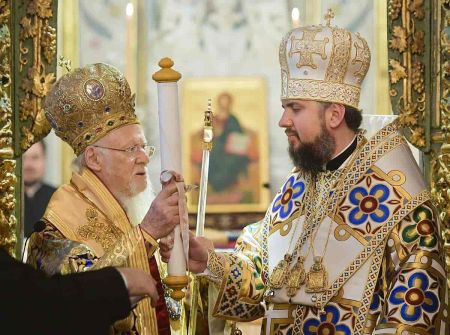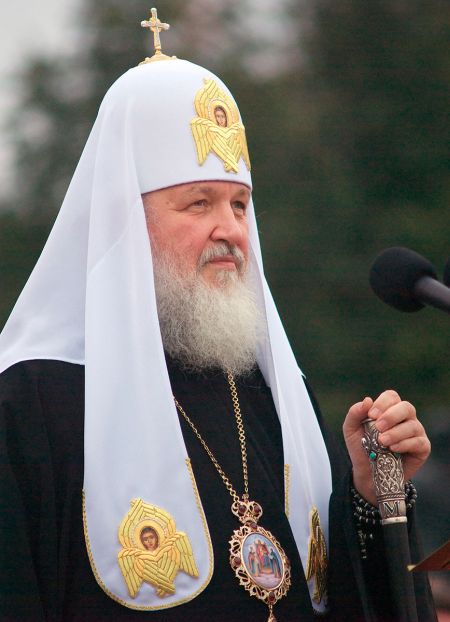How do Orthodox Christians Perceive the Russian Aggression in Ukraine?
The dominant religion in both Russia and Ukraine is Orthodox Christianity, a branch of Christianity that has developed independently from Western Christianity for a Millennium. Unlike the Roman Catholic Church, which is united under the Pope in Rome, the Orthodox Church is territorially divided into more than a dozen organisationally independent church units, called autocephalous churches. These churches, including the Russian Orthodox Church, the Serbian Orthodox Church and the Orthodox Church of Greece, among others, theologically claim to embody the true Church of Christ, but they are constantly involved in more or less serious conflicts with each other. The Russian invasion of Ukrainian territory end of February exacerbated many of these conflicts and called new ones into existence.
First, it is important to keep in mind that all Orthodox parishes in Ukraine used to belong to the Russian Orthodox Church during the Soviet era. However, because of the anti-religious communist ideology of the state on the one hand and the historical memory of other Christian allegiances in Ukraine on the other, this unity was fragile and fell apart during and immediately after the collapse of the Soviet Union in 1991. The fact that no viable Ukrainian independent state had existed before the Soviet Union complicates matters further, as different regions cherish different historical memories. The Eastern parts of the country, as well as the port city of Odessa, for example, have a long connection to the Russian Empire, whereas the Western regions were part of Habsburg Austria and later Interwar Poland and consider Russia a distant neighbour. However, in the years since the collapse of the Soviet Union, Ukraine has been able to surmount many dividing forces and has become a relatively unified country – not necessarily on the language question, but at least in terms of state loyalty and shared democratic values. There are obviously sections of the population who would not agree to this characterisation, but by and large, open conflicts are avoided.
Nevertheless, there are two arenas where this unity cannot be detected. That is, on the one hand, the break-away regions of Donetsk and Luhansk in the South-East. They are, however, strongly influenced from Russia, which has taken disguised steps to keep a military conflict raging there since 2014. On the other hand, it is the religious situation, for all attempts to unify the Orthodox parishes of Ukraine into one organisation have failed so far – not least because of the unwillingness of the Russian Orthodox Church to let go of what it sees as its rightful „canonical territory“. Christianity came to Russia through the medieval fiefdom of the Kievan Rus’, so Kyiv and the Ukrainian lands are seen as the birthlands of Russian Orthodoxy, similar to the Kosovo plains for the Serbian Orthodox Church. In addition, the Moscow Patriarchate, the central administration of the Russian Orthodox Church, has bought into the ideology of a Russian World (russkii mir) that unites all Russian speakers – including the Ukrainians – into a single civilisation with one, glorious Church organisation. It is therefore impossible for the Russian Church to simply let go of the Ukrainian part, all the more because nearly a third of its parishes are located there.
At the same time, there have been numerous attempts to establish church organisations in Ukraine that were independent from the Moscow Patriarchate. Since the early 1990s, two such churches existed: One of them was a revival of an interwar Ukrainian church structure that had survived in exile in North America throughout the Soviet era and the other was a self-proclaimed Patriarchate of Kyiv, a group that had split off from the mainstream church reporting to the Moscow Patriarchate. Neither of these two churches managed to achieve recognition by world Orthodoxy and therefore both remained illegitimate and pariah churches. This was the situation until 2018, when Ukrainian president Petro Poroshenko appealed to the Patriarchate of Constantinople in Istanbul, the honorific head of the worldwide Orthodox Church, to end the chaos in Ukrainian Orthodoxy.
The Patriarch obliged and decided later that year, after a process of studying documents and speaking to people, to summon an All-Ukrainian episcopal council for the establishment of an autocephalous Ukrainian Orthodox Church. All Orthodox Bishops in Ukraine, regardless of their current affiliation, were invited to this council, which gathered at the end of October 2018 in Kyiv. However, Patriarch Kirill of Moscow and his advisors categorically forbade the bishops of their church to take part in the synod, essentially making the event a unification of two unrecognised churches, with the resulting church being recognised as the legitimate Orthodox Church of Ukraine at least by the Patriarchate of Constantinople. The new church (called “Orthodox Church of Ukraine” (OCU), to distinguish it from the “Ukrainian Orthodox Church” (UOC) of the Moscow Patriarchate) was officially established through a “tomos”, a legal act in January 2019 with the young Bishop Epiphany at its helm. As a result, the Patriarchate of Moscow categorised Constantinople as schismatic and broke off communion, initiating a worldwide split in the Orthodox world that continues to this day. So far, however, most Orthodox Churches have declined to follow either one of the two sides – staying in communion with both Moscow and Constantinople, while stalling an official recognition of the new Orthodox Church of Ukraine. Only the churches of Greece, Cyprus and Alexandria (responsible for all of Africa) have taken the latter step, promptly followed by a Russian break in the communion. It is important to keep in mind that the break is one-sided – only the Russian Orthodox Church has drawn this consequence, whereas the other side (Constantinople, Greece, Cyprus, and Alexandria) does not denigrate the Russian Church.

Bartholomew hands over the tomos to Metropolitan Epiphany
(The Presidential Administration of Ukraine; cc-by-4.0)
All this is necessary to keep in mind when assessing the way the ongoing military conflict in Ukraine has affected Orthodox believers in Russia, Ukraine, and worldwide. There are at least three churches directly affected by the conflict – the Russian Orthodox Church (ROC), the Ukrainian Orthodox Church (UOC) of the Moscow Patriarchate and the autocephalous Orthodox Church of Ukraine (OCU). Moreover, Russian Orthodox parishes all over the world are torn, as they usually comprise both Russian and Ukrainian members and have mostly been able to shy away from political and ideological discussions so far.
The ROC, headed by Patriarch Kirill of Moscow is the easiest one to describe, as Kirill is entirely following the line and argumentation of Vladimir Putin. Kirill’s statements during the war have been ambiguous and refrained from naming an aggressor. Instead, Kirill calls for appeasement “on both sides” and is otherwise silent as to Russia’s role in the conflict. Also his entourage, which is usually quick to follow up, has been remarkably silent over the first week of the conflict. There are radical voices, but the most influential commentators are quiet.
The UOC, on the other hand, has been very outspoken from the beginning. Its head, Metropolitan Onuphry of Kyiv, made a remarkable statement on the day of the first Russian attacks, harshly condemning them, naming Russia as the aggressor and urging the faithful to stand firm in the defence of the fatherland. Moreover, he likened the attack to the “sin of Cain, who killed his own brother out of envy.” Hearing such a direct and open response from a Bishop, supposedly loyal to the Moscow Patriarchate, has even had an impact within Russia, where reliable information about the conflict is rather scarce. In Ukraine, it has resulted in several of the bishops (12 out of 42 on 3 March) prescribing that priests under their authority stop commemorating Patriarch Kirill of Moscow during the liturgy. This is the very first step on the way towards a separation from the Russian Church, it is still a harmless step, but it is possible that other actions follow. So far, Metropolitan Onuphry himself has not taken this step, which means that in terms of canon law, there is no institutional separation between the UOC and the ROC up to now.
From the OCU, the response has been similar. Its head, Metropolitan Epiphany, sees himself as being on the moral high horse, since his church is not associated with the Russian aggressor. His statements echo those of President Zelensky and Western condemnations of the military conflict. At the same time, Epiphany has made a direct appeal to Patriarch Kirill in Moscow, deploring him to at least enable the priests in Russia to pray for the souls of those Russian soldiers that have fallen so far. Because, as Kirill follows the official line of the Putin regime, from the latter’s perspective there have been no casualties in this conflict, which is a peace-keeping mission and no war. This way, Metropolitan Epiphany is appealing to the Christian conscience of Patriarch Kirill, hoping that he reconsiders his influence in Russian politics.

Patriarch Kirill of Moscow (Serge Serebro; cc-by-sa)
In each of these cases, the first religious response is naturally a short-term one. It remains to be seen if anything lasting will emerge from this. For one, Patriarch Kirill of Moscow must at some point realise that it does not do the image of the Russian Church any good, both within Russia and in the wider world, to be associated with a fratricidal military aggression that does not follow the international rules of violent conflicts. Nobody knows how Kirill will be able to wind his way out of this compromising realisation, or whether he will still be able to wield the same kind of influence over the believing population in the aftermath of such a misjudgement. Within Ukraine, there are influential theological voices, such as the internationally respected Cyril Hovorun, that call for the bishops of UOC and OCU to seize the opportunity and finally find a way to join together in a single Ukrainian Orthodox Church. Hovorun’s solution is to convene a second “unification council”, this time excluding any attempts from Moscow to influence the outcome.
If this happens, there might be a chance that Putin’s aggression not only destroys what is left of his own standing in the political world, but that even the Russian Orthodox Church loses its most strategic ecclesiological weapon, its parishes in Ukraine. If that happens, the main reason for the unilateral attempt of the Moscow Patriarchate to destabilise the Orthodox world in order to gain more influence would backfire, and the primacy of the Constantinople Patriarch would probably be reaffirmed. Until this can be assessed, however, there are much more urgent issues to be tackled, related to limiting the impact of further military conflict and alleviating the humanitarian consequences of the situation. The religious aspect has definitely been important for the perception of and in the runup to the conflict, and the religious landscape will be affected by it, but it is unlikely to play a decisive role in its resolution.


